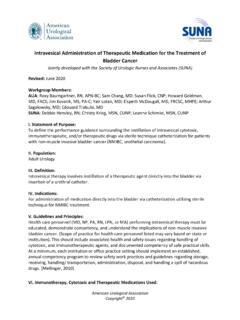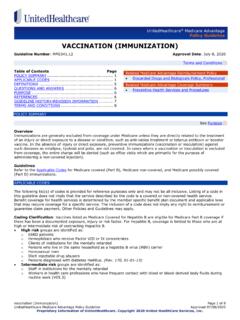Transcription of Chapter 7 - Urodynamics
1 Committee 7 UrodynamicsChairmanY. HOMMA(JAPAN)MembersJ. BATISTA(SPAIN),S. BAUER(USA),D. GRIFFITHS(USA),P. HILTON( ),G. KRAMER(GERMANY),G. LOSE(DENMARK),P. ROSIER(THENETHERLAND) FORFUTURE RESEARCHII. RECOMMENDATIONS FOR CLINICALPRACTICEI. GENERALCONCLUSIONSE. CONCLUSIONSVI. FRAILELDERLYV. CHILDRENIV. NEUROGENIC LOWER URINARYTRACTDYSFUNCTIONIII. ADULT(FEMALE)II. ADULTS (MALE)I. GENERALC. CLINICALAPPLICATIONOFURODYNAMIC STUDIESIX. INTRINSIC SPHINCTER DEFICIENCYVIII. AMBULATORYURODYNAMICMONITORINGVII. VIDEOURODYNAMICSVI. SURFACE ELECTROMYOGRAPHYV. PRESSURE-FLOWSTUDIES OFVOIDINGIV. UROFLOWMETRYAND RESIDUALURINE MEASUREMENTIII. LEAK POINTPRESSUREMEASUREMENTII. URETHRALPRESSURE MEASUREMENTI. CYSTOMETRYB. URODYNAMIC STUDIESII.
2 THE GENERALASPECTS OFURODYNAMICS IN INCONTINENCEASSESSMENTI. INTRODUCTION A. GENERALREMARKS318 CONTENTS Chapter7In preparing this Chapter , one of the main goals of thecommittee has been to present evidence for the abilityor inability of urodynamic investigation to improve orat least predict the outcome of treatment for inconti-nence. In spite of the fundamental importance of uro-dynamics, the committee has found that for each typeof test the evidence is based either on case series (level4 evidence) or expert opinion (level 5 evidence). Forthis reason it has not repeatedly restated the levels ofevidence, but has graded each of its final recommenda-tions for clinical practice on the basis of these levels ofevidence.
3 Inevitably, one of the principal recommenda-tions is for clinical research studies to improve the qua-lity of the lower urinary tract is composed of the bladder andurethra. They form a functional unit to store and eva-cuate urine. During the normal storage phase, as thebladder is filled with urine, a sensation of filling is per-ceived at a certain moment and subsequently a desire tovoid is felt. Normally no uncomfortable sensation suchas urgency, pain or discomfort is perceived and no uri-nary leakage occurs. Competence of the urethra andaccommodation of the bladder make it possible to storeurine at a low and stable pressure. The low storage pres-sure insures adequate drainage of urine flow from theupper urinary tract.
4 The normal voiding phase is cha-racterized by the voluntary initiation of micturition fol-lowed by forceful and continuous flow with no residualurine. Coordinated relaxation of pelvic floor and exter-nal urethral sphincter as well as detrusor contractioncontribute to the efficient emptying of the bladder. Uri-nary flow can be intentionally interrupted by voluntarycontraction of urethral sphincter and pelvic floor. Ner-vous control mechanisms, central and peripheral aswell as somatic and autonomic, integrate these func-tions (Figure 1). Accordingly, two broad types of lower urinary tractdysfunction may be distinguished: dysfunction of stora-ge and dysfunction of voiding. Clearly urinary inconti-nence, represents a failure to store urine adequately, butit can be associated with or aggravated by some typesof voiding dysfunction of neurogenic, mechanical orfunctional etiology.
5 Failure to store urine at low pressu-re or emptying at high pressure may affect upper urina-ry tract drainage and eventually its function. Occasio-nally, leakage may occur through channels other thanthe urethra. This is extra-urethral incontinence. Urodynamic investigation is a functional assessment ofthe lower urinary tract to provide objective pathophy-siological explanations for symptoms and/or dysfunc-tion of the lower and upper urinary tracts. Urodynamicstudies comprise a series of tests. The appropriatetest(s) should be selected and performed in an attemptto answer well-defined question(s) on the target func-tions to be evaluated (Table 1). In the case of inconti-nence, the most relevant of these tests are directly rela-ted to the incontinence itself; that is, they aim todemonstrate involuntary leakage in the test with or without simultaneous imaging,ambulatory Urodynamics and the measurement of leakpoint pressures are the primary examples of such urodynamic tests have an indirect relation to theincontinence.
6 The information provided by these stu-dies may be useful in establishing etiology and may beclinically important by helping to select the most appro-priate intervention. Uroflowmetry, residual urine mea-surement and pressure-flow studies are the clinical work-up of an incontinent patient, uro-dynamic studies are indicated for the following reasons:- to identify or to rule out the factors contributing tothe incontinence and their relative importanceI. INTRODUCTION A. GENERALREMARKS319 UrodynamicsY. HOMMA,J. BATISTA, S. BAUER, D. GRIFFITHS, P. HILTON, G. KRAMER, G. LOSE, P. ROSIER320 Figure 1 : Illustrative normal urodynamic findings with fluoroscopic imagings. intravesical pressure (pves), abdominal pres-sure (pabd), detrusor pressure (pdet: pves-pabd), urethral pressure (pura) measured at the point of maximum urethral pres-sure, Pura-Pves, urinary flow (Q) and surface electromyography (EMG) during the storage and voiding phases are idealized.
7 Table 1 : Urodynamic Studies for Urinary Incontinence AssessmentUrodynamic studyTarget function to be evaluatedIndicated patients1. Cystometrystorage function and sensation of the bladder any incontinent subjects to beduring the filling phaseinvestigated for their dysfunctional conditions2. Urethral pressure urethral closing forcessubjects suspected of urethralmeasurementincompetence3. Leak point pressure urethral competence against pressure generatedsubjects suspected of neurogenic lowermeasurementin the bladder from detrusor or abdominal forcesurinary tract dysfunction (A) orA. Detrusorurethral incompetence (B)B. Abdominal4. Uroflowmetry, global voiding function any incontinent subjects (residual) or Residual urine measurementthose suspected of voiding dysfunction (uroflow)5.
8 Pressure-flow studiesdetrusor contractility and bladder outlet subjects suspected of voiding obstruction during the voiding phasedysfunction6. Surface electromyographycoordinated relaxation of pelvic floor during subjects suspected of dysfunctional or the voiding phasedyssynergic voiding7. VideourodynamicsSimultaneous observation of the morphology subjects with suspected multifactorial and function of the lower urinary tractetiologies for incontinence or anatomical abnormalities of the lower urinary tract8. Ambulatory urodynamic behavior of bladder (and urethra) and leakagesubjects suspected but not proven tomonitoringmechanisms during activities of daily livinghave incontinence or detrusor overactivity on conventional investigations- to obtain information about other aspects of thelower urinary tract dysfunction- to predict the consequences of the dysfunction forthe upper urinary tract - to predict the outcome, including undesirable sideeffects, of a contemplated to confirm the effects of treatment or to understandthe mode of action of a particular type of treatment,especially a new one- to understand the reasons for failure of previoustreatments for incontinenceIn short.
9 Urodynamic studies are indicated to objective-ly observe lower urinary tract function and dysfunctionwith the idea of choosing an appropriate treatment forthe incontinence and its associated pathology. Basical-ly, the urodynamic study should be performed andreported in accordance with the standards of the Inter-national Continence Society (ICS) [1], so as to optimi-ze interpretation and facilitate comparison between dif-ferent studies. This principle is applied hereafter;however, the Chapter is not intended to simply reprodu-ce the ICS standardization report but rather to focus onthe clinical relevance of Urodynamics to urinary incon-tinence. It includes recommendations for study proce-dures, interpretation of study results and the ability topredict treatment.
10 Electrophysiological studies are trea-ted in more detail in Chapter investigations must be carried out in asafe, comfortable, and scientific manner, and should bereproducible within the limits of physiological variabi-lity, if repeated. This section emphasizes points that arepertinent to all urodynamic studies in the assessment ofincontinence [2, 3]. These points will be repeated inother sections of this Chapter where relevant to the dis-cussion. Further details are available in textbooks [4-8]. to the urodynamic investigation a medical history,a physical examination and/or a voiding diary should betaken. Such information is absolutely necessary toselect the appropriate studies and to anticipate whatevents might take place during the urodynamic patient should be informed of the procedures befo-re the studies, preferably by written leaflets but in anyevent by oral explanation.








